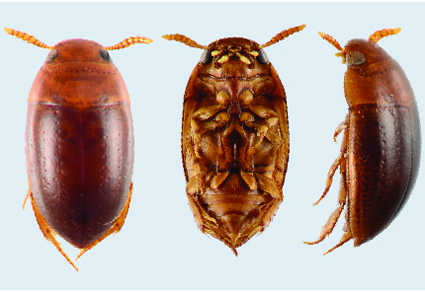Abstract
Prionohydrus cambyreta sp. nov. is described from the Iberá wetlands, Corrientes Province, Argentina. Diagnostic characters are described and illustrated in detail, and the new taxon is compared with the other four South American species of Prionohydrus Gómez & Miller, 2013. In external appearance, P. cambyreta is very similar to P. matogrossensis Gómez & Miller 2013, but it can be distinguished by the shape of the male genitalia. The new species represents the most southern record for Prionohydrus, extending the distributional range of the genus by about 1700 km.
References
- Baca, S.M., Toussaint, E.F.A., Miller, K.B. & Short, A.E.Z. (2017) Molecular phylogeny of the aquatic beetle family Noteridae (Coleoptera: Adephaga) with an emphasis on data partitioning strategies. Molecular Phylogenetics and Evolution, 107, 282–292. https://doi.org/10.1016/j.ympev.2016.10.016
- Belkaceme, T. (1991) Skelet und Muskulatur des Kopfes und Thorax von Noterus laevis Sturm. Ein Beitrag zur Morphologie und Phylogenie der Noteridae (Coleoptera: Adephaga). Stuttgarter Beiträge zur Naturkunde, Serie A, 462, 1–94.
- García Ramírez, M. (2018) Prionohydrus plurunum, nueva especie de coleóptero acuático (Coleoptera: Hydradephaga: Noteridae) del sudeste de Venezuela. Revista Chilena de Entomología, 44, 419–426. https://doi.org/10.22458/urj.v10i1.2024
- García Ramírez, M. (2019) El género Mesonoterus Sharp (Coleoptera: Noteridae: Noterinae: Noterini) en Venezuela, con descripción de siete nuevas especies. Revista Chilena de Entomologia, 45 (1), 93–121.
- Gómez, R.A. & Miller, K.B. (2013) Prionohydrus, a new genus of Noterini Thomson (Coleoptera: Noteridae) from South America with three new species and its phylogenetic considerations. Annals of the Entomological Society of America, 106, 1–12. https://doi.org/10.1603/AN12041
- Guignot, F. (1948) Vingt-cinquième note sur les Hydrocanthares. Revue française d’entomologie, 15 (2), 96–100.
- Herbst, C., Baier, B., Tolasch, T. & Steidle, J.L.M. (2011) Demonstration of sex pheromones in the predaceous diving beetle Rhantus suturalis (MacLeay 1825) (Dytiscidae). Chemoecology, 21, 19–23. https://doi.org/10.1007/s00049-010-0061-3
- Michat, M.C., Alarie, Y. & Benetti, C.J. (2022) Larval morphology of the Neotropical diving beetle genus Hemibidessus Zimmermann, 1921 (Coleoptera: Dytiscidae: Bidessini). Zootaxa, 5168 (3), 388–400. https://doi.org/10.11646/zootaxa.5168.3.9
- Miller, K.B. & Bergsten, J. (2023) Predaceous diving beetle sexual systems. In: Yee, D.A. (Ed.), Ecology, systematics, and the natural history of predaceous diving beetles (Coleoptera: Dytiscidae). Second Edition. Springer, New York, New York, pp. 187–224. https://doi.org/10.1007/978-3-031-01245-7_4
- Miller, K.B. & Nilsson, A.N. (2003) Homology and terminology: Communicating information about rotated structures in water beetles. Latissimus, 17, 1–4.
- Neiff, J.J. & Poi de Neiff, A.S.G. (2006) Situación ambiental en la Ecorregión Iberá. In: Brown, A.D., Martínez Ortíz, U., Acerbi, M. & Corcuera, J. (Eds.), La situación ambiental argentina 2005. Fundación Vida Silvestre Argentina, Buenos Aires, pp. 176–194.
- Rubio, G.D., Nadal, M.F., Munévar, A.C., Ávalos, G. & Perger. R. (2018) Iberá Wetlands: diversity hotspot, valid ecoregion or transitional area? Perspective from a faunistic jumping spiders revision (Araneae: Salticidae). Species, 19, 117–131.
- Urcola, J.I., Alarie, Y., Benetti, C.J. & Michat, M.C. (2020) Description of the larval stages of Hydrocanthus socius Sahlberg, 1844 (Coleoptera: Noteridae) with chaetotaxy analysis. Annales Zoologici, 70, 687–695. https://doi.org/10.3161/00034541ANZ2020.70.4.012
- Urcola, J.I., Benetti, C.J., Alarie, Y., Urcola, M.R. & Michat, M.C. (2024) Description of the first- and third-instar larvae of Hydrocanthus levigatus (Brullé, 1837) (Coleoptera: Noteridae). Aquatic Insects, 45, 260–272. https://doi.org/10.1080/01650424.2023.2245802
- Urcola, J.I. & Michat, M.C. (2023) Noteridae. In: Roig-Juñent, S.A., Claps, L.E. & Morrone, J.J. (Eds.), Biodiversidad de Artrópodos Argentinos. Vol. 5. Editorial INSUE UNT, San Miguel de Tucumán, pp. 190–197.


